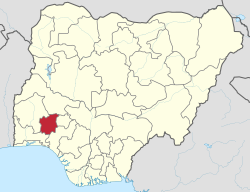INTRODUCTION
Osun is one of the six states that make up the South-West geopolitical zone of Nigeria. It has interstate boundaries with Ondo State to the Southeast, Kwara State to the North, Ekiti State to the Northeast, Oyo State to the West, and Ogun State to the Southwest. The state capital is Osogbo.
LANDMASS, LOCATION AND POPULATION
Osun State covers an area of 9,251 square kilometres. It lies at latitude 7°30′ North and longitude 4°30′ East. It has a population of 3,416,959 (2006 census) 4,705,589 (2016 forecast) and a population density of 369. The state accounts for 2.4% of Nigeria's total population.
HISTORY AND PEOPLE
The early settlers of Osun State were the Yoruba people. The state derives its name from the Osun River which flows through it. Osun State was originally part of the Western Region in the three-region structure of 1954. With the creation of twelve federal states by General Yakubu Gowon's military government in 1967, Osun State became part of Western State. The military government of General Murtala Muhammed created nineteen states out of the existing twelve in 1976 and Osun State became part of Oyo State. In 1991, the military government of General Ibrahim Babangida divided Oyo State into present-day Oyo and Osun states.
The main ethnic group in Osun State is the Yoruba people and Yoruba is the only indigenous language in the state. Christianity and Islam are the main religions in Osun State, although traditional religion is practised there.
MAIN TOWNS AND CITIES
Osogbo (capital), Ede, Ejigbo, Ila Orangun, Ile-Ife, Ilesa, Ilobu, Iwo and Modakeke.
LOCAL GOVERNMENT AREAS
ADMINISTRATORS AND GOVERNORS
Segun Ajiborisha (Governor - Military): August 1991 - January 1992
Isiaka Adeleke (Governor - Civilian (Social Democratic Party)): January 1992 - November 1993
Anthony Udofia (Administrator - Military): December 1993 - August 1996
Anthony Obi (Administrator - Military) August 1996 - August 1998
Theophilus Bamigboye (Administrator - Military) August 1998 - May 1999
Adebisi Akande (Governor - Civilian (Alliance for Democracy)) May 1999 - May 2003
Olagunsoye Oyinlola (Governor - Civilian (People's Democratic Party)) May 2003 - November 2010
Rauf Aregbesola (Governor - Civilian (Action Congress of Nigeria/All Progressives Congress)) November 2010 - November 2018
Gboyega Oyetola (Governor – Civilian (All Progressives Congress): November 2018 – Present
ECONOMY AND EDUCATION
Farming is the main occupation in Osun State. The state’s various food crops include yam, cassava, cocoyam, maize, vegetables, fruits, corn and beans. Poultry and fish are also important. Their main cash crops are cocoa and kola nut. The major minerals found in Osun State include gold, clay, limestone and granite. A number of agro-allied industries are located in the state. The traditional crafts of cloth weaving (aso-oke) and tie-and-dye fabric (adire) making are also of commercial importance in the state.
The tertiary institutions in the state are Obafemi Awolowo University, Ile-Ife; Osun State University, Osogbo; Ladoke Akintola University Teaching Hospital, Ogbomosho; Bowen University, Iwo; Adeleke University, Ede; Joseph Ayodele Babalola University, Ikeji-Arakeji; Fountain University, Osogbo and Federal Polytechnic, Ede and Osun State Polytechnic, Iree.
FAMOUS SITES AND CULTURE
Sites
Nelson Mandela Freedom Park, Osogbo
The Nelson Mandela Freedom Park in Osogbo was named after South Africa’s anti-apartheid hero and its first black president. It was established by the state government as a recreational centre and regarded as the best in the state.
Osun-Osogbo Sacred Grove, Osogbo
The Osun-Osogbo Sacred Grove is a cultural landscape along the bank of River Osun on the outskirt of Osogbo and covers 75 hectares of land. It is regarded as the home of the Yoruba goddess of fertility, Osun Osogbo. The Grove, according to history, was discovered by an elephant hunter during one of his expeditions several years ago. An Austrian artist, Susan Wenger, managed the Grove until her death in 2009.
Wenger, who later earned the name Adunni Olorisha, alongside several other artists saved the Grove from demolition by erecting huge sculptures made of iron and mud. The Osun-Osogbo Sacred Grove was listed as a UNESCO World Heritage Site in 2005.
Opa Oranmiyan, Ile Ife
The Opa Oranmiyan is a legendary staff installed several centuries ago by Oranmiyan, son of Oduduwa, the Yoruba divine king. It is a stand-alone staff and shaped like an elephant tusk with its body decorated with over 100 nails arranged in the form of an elongated trident. The staff which is more than 18 feet high symbolises the essence of Ile Ife as the ancestral home of the Yorubas. The Opa Oranmiyan is located inside the Oranmiyan Shrine in Moopa in the Aribidi end of Ile Ife.
Culture
The Osun-Osogbo Festival is a cultural event marked in August every year to celebrate the Yoruba goddess of fertility. Devotees visit the Osun-Osogbo Sacred Grove during the festival and present offerings to the goddess while barren women seek her blessings. Other cultural events in the state include the Egungun (masquerade), Ifa and Olojo Festivals.
NOTABLE INDIGENES
Bola Ige (1930 -2001)
Isiaka Adeleke (1955 – 2017)
DID YOU KNOW
The oldest evidence of habitation at Ife dates back to early 600BCE.
OSUN STATE IN PICTURES

